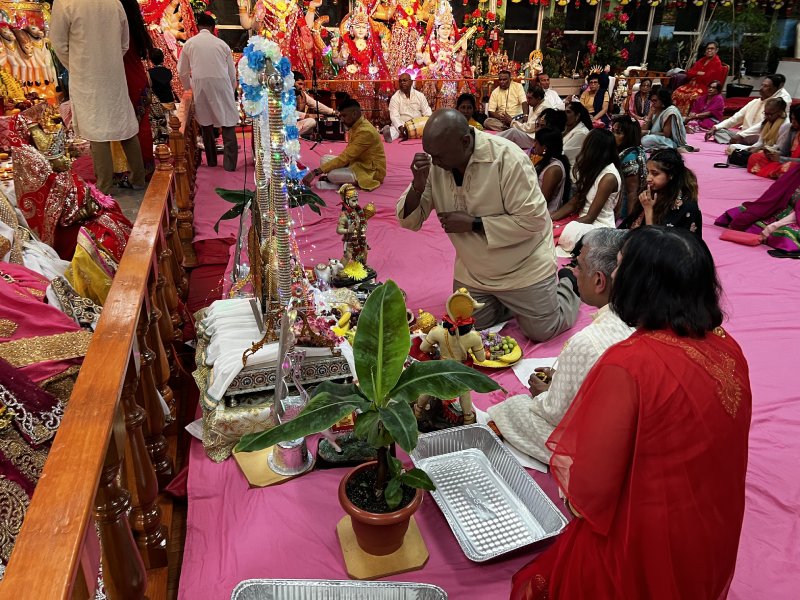Indo-Caribbean American and other Hindus observed Ram Naumi (Navami), the birth or appearance of Lord Rama, last Thursday March 30. Temples of all nationalities (Guyanese, Trinidadian, Asian Indian, Nepali, Bangladeshi) were packed to capacity in the day as well as for the evening service. Hindus also celebrated the occasion at home and places of work. At the temples, they made offerings and performed oblations on their God.
Lord Rama, according to the Hindu holy scriptures, made his appearance as a baby on earth over 5,000 years ago. Hindus celebrated his birth last Thursday at noon in the Greater New York area. The celebration of ram Navami culminates the end of the Navratri (nine days) fasting period that commenced on March 22.
Guyanese and other temples were packed to capacity with worshippers in the greater New York area where hundreds of thousands of Guyanese Hindus are settled. There are dozens of Guyanese oriented Mandirs in the NY metro area, including Schenectady, New Jersey, Connecticut and Pennsylvania. There are also Guyanese mandirs in Miami, Ft Lauderdale, Dallas, Houston, Minneapolis, Atlanta and a few other cities where there are large clusters of Guyanese. Guyanese, Trinis, Surinamese, and Jamaicans tend to patronize each other’s temple where Navratri and Ram Naumi services were held.
Ram Naumi is tied to Navratri, the holiest period in the Hindu calendar. Navratri is one of the most auspicious periods in the Hindu calendar and during this time the feminine aspects of God are worshipped. There are two Navratri – one in the Spring when Lord Rama was birthed and another in the Fall when Ram slayed Ravan (evil). Almost all temples held religious discourses (read and discussions) from the Ramayana or other holy books. Some mandirs only held discourses on selected nights. Worshippers, well attired, in traditional Indian outfits were observed praying during this period with great fervour and devotion.
Large crowds thronged mandirs for the nine nights of religious observance and propitiation of the feale Goddesses (Durga, Saraswati, Laxmi) — three Devis and for the birth of the Lord. Hindus view Lord Ram as the seventh incarnation of Lord Vishnu. They believe that when the evil forces were out to destroy the world, Lord Vishnu (Preserver) incarnated as Lord Rama and made his appearance on earth to save the world and to re-establish dharma – righteous life.
Devotees fasted (avoiding meat, fish, eggs, and sexual desires) and visited temples and or conducted prayers at homes on the preceding days. Many observed a strict fast, avoiding food during the day for over two weeks. Fasting, pandits explained, is good for the body’s health. Many conducted pujas at home or in the mandir. Some sponsored pujas or Ramayana kathas (discourses) as is the custom in Guyana, Trinidad, Suriname, and elsewhere. During Navratri and Ram Naumi, the holy ‘Ramayana’ was read with a discourse during Navratri and on Ram Navami and their lessons explained by the presiding pandits. Hindus believe that chanting Lord Rama’s name removes all obstacles and of devotees and place them on the path to prosperity. Lord Shri Rama fulfils the wishes and desires of devotees who genuinely worships him, according to the pandits. The discourse was accompanied by singing of bhajans and choral singing and drumming as well as the playing of other musical equipment. A ‘palna’ or hammock was rocked by devotees with a small Lord Rama murthi to replicate (mock) the nursing of Baby Ram.

Ram Naumi culminates the fasting period for Hindus. the reason for the propitiation of Lord Rama.
Elaborate vegetarian meals were prepared nightly for Navratri and for the celebration of the lord’s birthday on Thursday. Some mandirs also served vegetarian cake and as well as ‘lapsey’ with puri and Halwa (which Hindus normally served nine days after a baby is born) with special ‘dosti’ (a very thin) roti.
